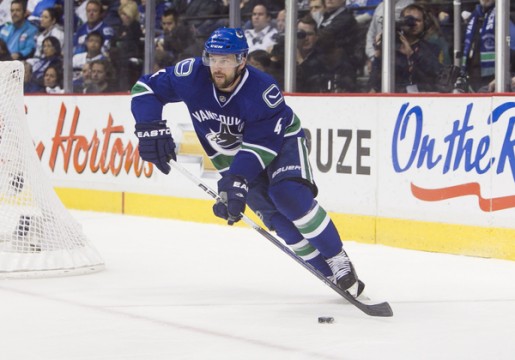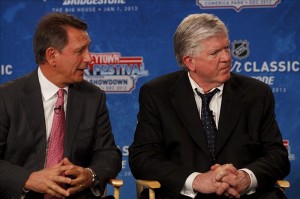
The never-ending NHL CBA negotiations have been a drag for everyone…unless you’re a well-paid lawyer involved in the conflict or an overextended General Manager in search of relief.
Both the league and Players’ Association have made significant moves toward a settlement in recent days and — barring a last second disaster — we should have hockey back on the ice in a matter of weeks.
From the NHLPA perspective, Chris Johnston at The Canadian Press reported that a cap on escrow was off the table as of Wednesday night. The details behind the escrow dynamic are best left for a day when fans aren’t recovering from the holidays and 4am World Junior Championship wakeup calls, but trust us, it’s a significant concession by the PA. (If you’re really starved for escrow, Greg Wyshynski had good introductory links and commentary in this piece on Wednesday)
On the flip side, one source told TheHockeyWriters.com that the NHL is willing to go as high as 30 percent on year-to-year contract variance after initially demanding 5 percent. The league has also reportedly offered teams the opportunity for two compliance buyouts next offseason when the salary cap will drop as much as $5 or $10 million.
Buyouts are just a slice of a bigger pie that’s often referred to as compliance issues. The league realizes that with a number of teams already heavily committed to salaries for next season there need to be mechanisms in place to ease transition to a lower salary cap.
So what exactly is a compliance buyout?
After the NBA underwent a similar salary cap lowering and adjustment this past offseason, teams were given the option of a one-time amnesty buyout. Under basketball’s rules, for any player bought out through the amnesty provision:
- The player is still paid in full
- The team gets to remove his salary from their books for cap and luxury tax purposes
- The player enters a bidding pool of teams that are under the salary cap
- Teams can bid to assume some (but not all) of the player’s contract and the highest bidder is awarded the player
- If no team claims the player, he becomes an unrestricted free agent
Over half of NBA teams used the provision ranging from $37 million saved by Dallas for Brendan Haywood to $4 million saved by the Los Angeles Clippers for depth player Ryan Gomes. The NBA rules could make for some interesting salary cap decisions and maneuvering if they were adopted by the NHL, but under the 2005 CBA, compliance buyouts were a little more straightforward.
The 2004-05 lockout ushered in a new salary cap system and over-committed teams needed a way to wiggle under the cap ceiling. The new CBA called for a six-day window where teams were permitted to terminate and buy out player contracts, otherwise known as compliance buyouts. 14 players were bought out during the window including big name stars like John Leclair, Tony Amonte, Bobby Holik, and Ray Whitney.
Under the rules detailed in Article 50 of the CBA:
- Players could be bought out for two-thirds of their remaining salary
- Money owed to the player had to be paid out over the remaining length of the terminated contract — unlike Ordinary-Course Buyouts (which teams can exercise each offseason) where owed money is paid out over twice the length of the contract
- Teams could not pay owed money in a lump sum
- Players could not re-sign with the original team until after the 2005-06 season
- Compliance buyouts did not count against the team’s salary cap, nor did they count against the total player compensation for that year
Barring major changes (we’ve learned anything can happen in these negotiations), the rules for compliance buyouts should be similar to 2005. According to recent reports, the NHL is insisting that the buyouts count against total player compensation, but this will only have an impact on escrow, not on individual team salary cap numbers.
Cap Creativity

It’s almost impossible to envision a scenario where 60 players are bought out during the compliance buyout window.
Teams with plenty of cap flexibility have no incentive to exercise compliance buyouts instead of the always available ordinary-course buyouts. There’s also only a handful of players that cap-strapped teams will happily pay millions of dollars not to play for their team in 2013-14. It’s also important to note that teams can’t buy out injured players — so forget all those Chris Pronger and Marc Savard compliance buyout reports you’ve seen this week.
Where it could get interesting is if the big and small market teams decide to work together. Let’s look back to the NBA for an example.
In February 2011, the Cleveland Cavaliers traded Mo Williams and Jamario Moon to the Los Angeles Clippers for Baron Davis and a first-round pick. The Cavaliers ended up winning the NBA draft lottery with that pick and eventually selected Kyrie Irving first overall. When the NBA settled it’s lockout in December 2011, Cleveland used the amnesty provision to buy out Davis’ contract with nearly $30 million remaining over two seasons.
The Davis scenario certainly contained an element of luck, but would Brian Burke and the Toronto Maple Leafs (who made an estimated $82 million in operating revenue last season) take on an albatross contract and a high draft pick this year with the intent of utilizing the compliance buyout window next summer?
Burke took two deadweight contracts (Olaf Kolzig and Jamie Heward were out for the season with injuries) off the hands of cash-strapped Tampa Bay at the 2009 trade deadline and essentially received a fourth-round pick for the favor. With new ownership and heading into what could be his last season as Leafs GM, Burke might have the green light to do anything he needs to in order to acquire assets.
Would a move like this “violate the integrity of the CBA” and be seen as cap circumvention?
It’s tough to say.
Here’s another example. Let’s say Burke signs free agent forward Eric Fehr to a three-year contract at $2 million per season after the lockout ends. If Fehr works out, the Leafs have him locked up for two more years at a reasonable cap hit. If he doesn’t, Burke uses the compliance buyout on him and it doesn’t affect Toronto’s cap situation going forward. Fehr gets most or all of his money and Burke gets a high-upside gamble.
The easiest way to prevent abuse would be to limit compliance buyouts to only players that were on a team’s roster as of the lockout. But give a group of NHL capologists a few hundred pages of new rules and exceptions, and they’ll always find loopholes to exploit.
[Update January 6: Per Nick Kypreos of Sportsnet, teams will be allowed to exercise buyouts in the 2013-14 and 2014-15 offseasons only. They are also allowed to use both in one year.]
___________________________________________
confused…